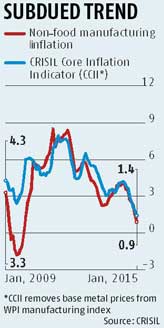Decline in inflation reflects subdued manufacturing inflation and a sharp fall in fuel inflation. Primary article inflation did rise by 3.27 per cent y-o-y in January from 2.2 per cent last month on the back of food inflation, which witnessed an uptick at 8 per cent y-o-y as compared to 5.2 per cent in December. Non-food inflation declined by 4.1 per cent, a sharper pace of decline when compared to decline of 3 per cent in December. Rise in food inflation was on account of higher inflation in vegetables (19.7 per cent), fruit (17.2 per cent) and pulses (12.3 per cent).
The sharpest fall was witnessed in prices of fuel articles. Prices contracted by 10.7 per cent in fuel and power. Inflation dropped most in petrol (-17.1 per cent), followed by diesel (-10.4 per cent) and LPG (-7.6 per cent). Crude oil prices for the Indian basket dropped to $46.6/bbl in January against $61.2/bbl in December. We expect oil prices to remain benign. We expect crude oil prices to reach $60-65/barrel (Brent) in 2015-16 from $85/barrel in 2014-15. Prospects of lower oil prices over the medium term will also temper inflationary expectations.
Core inflation - an indicator of demand-side pressure on prices - continued its downward journey in January. Non-food manufacturing inflation fell to 0.9 per cent y-o-y from 1.5 per cent in December with the following items recording negative inflation - metals (-0.9 per cent), leather products (-0.4 per cent) and textiles (-0.2 per cent). Inflation moderated in beverages & tobacco products, wood & wood products, paper & paper products, and chemicals.

In January, overall basic metals inflation remained subdued (-0.9 per cent) with metal and ferrous metals decline in inflation offsetting the rise in non-ferrous metals inflation (2.4 per cent). However, CCII and the non-food manufacturing inflation were at slight variance. This is because CCII includes manufactured or processed food prices which remained almost unchanged at 1.8 per cent in January as compared to 1.7 per cent in December. That said, CCII dropped by 0.4 percentage points while the decline in non-food manufacturing was larger at 0.7, against the December figures. The slight increase in manufactured food products was on account of an increase in grain mill products inflation to 3.1 per cent in January from 1.7 per cent in December. Inflation in most other categories manufactured food product categories moderated in January compared to previous month.
The GDP deflator based on the news data series shows 3.8 per cent inflation for 2014-15. The lower-than-expected inflation in the new CPI series and WPI inflation entering the negative territory makes us pencil in a repo rate cut following the Budget.
You’ve reached your limit of {{free_limit}} free articles this month.
Subscribe now for unlimited access.
Already subscribed? Log in
Subscribe to read the full story →

Smart Quarterly
₹900
3 Months
₹300/Month
Smart Essential
₹810
1 Year
₹67/Month
Super Saver
₹1,170
2 Years
₹48/Month
Renews automatically, cancel anytime
Here’s what’s included in our digital subscription plans
Access to Exclusive Premium Stories
Over 30 subscriber-only stories daily, handpicked by our editors


Complimentary Access to The New York Times
News, Games, Cooking, Audio, Wirecutter & The Athletic
Business Standard Epaper
Digital replica of our daily newspaper — with options to read, save, and share


Curated Newsletters
Insights on markets, finance, politics, tech, and more delivered to your inbox
Market Analysis & Investment Insights
In-depth market analysis & insights with access to The Smart Investor


Archives
Repository of articles and publications dating back to 1997
Ad-free Reading
Uninterrupted reading experience with no advertisements


Seamless Access Across All Devices
Access Business Standard across devices — mobile, tablet, or PC, via web or app



)
